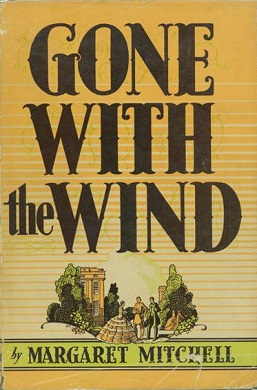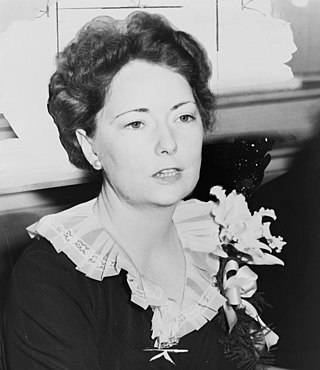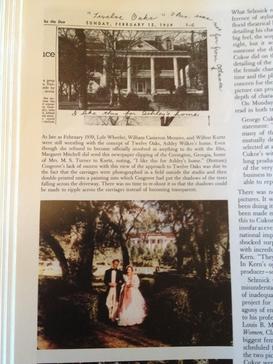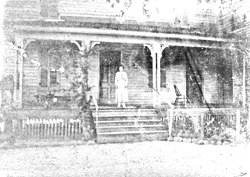
Gone with the Wind is a novel by American writer Margaret Mitchell, first published in 1936. The story is set in Clayton County and Atlanta, both in Georgia, during the American Civil War and Reconstruction Era. It depicts the struggles of young Scarlett O'Hara, the spoiled daughter of a well-to-do plantation owner, who must use every means at her disposal to claw her way out of poverty following Sherman's destructive "March to the Sea". This historical novel features a coming-of-age story, with the title taken from the poem "Non Sum Qualis eram Bonae Sub Regno Cynarae", written by Ernest Dowson.

Margaret Munnerlyn Mitchell was an American novelist and journalist. Mitchell wrote only one novel, published during her lifetime, the American Civil War-era novel Gone with the Wind, for which she won the National Book Award for Fiction for Most Distinguished Novel of 1936 and the Pulitzer Prize for Fiction in 1937. Long after her death, a collection of Mitchell's girlhood writings and a novella she wrote as a teenager, titled Lost Laysen, were published. A collection of newspaper articles written by Mitchell for The Atlanta Journal was republished in book form.

Mary Boykin Chesnut was an American writer noted for a book published as her Civil War diary, a "vivid picture of a society in the throes of its life-and-death struggle." She described the war from within her upper-class circles of Southern slaveowner society, but encompassed all classes in her book. She was married to James Chesnut, Jr., a lawyer who served as a United States senator and officer in the Confederate States Army.
Tara is the name of a fictional plantation in the state of Georgia, in the historical novel Gone with the Wind (1936) by Margaret Mitchell. In the story, Tara is located 5 miles (8 km) from Jonesboro, in Clayton County, on the east side of the Flint River about 20 miles (32 km) south of Atlanta.

Chippokes State Park is a Virginia state park on the south side of the James River on the Captain John Smith Chesapeake National Historic Trail. In addition to forests and fossil hunting on the beach, it includes three historic houses as well as an open-air agricultural and forestry museum with seasonally appropriate events. Other recreational facilities include a visitor center, swimming pool, hiking trails, cabins, yurts and campgrounds). It is located at 695 Chippokes Park Road, in rural Surry County, Virginia off Route 10.
In 1824, in appreciation of the enormous service rendered to this country by the Marquis de Lafayette during the Revolutionary War, Congress voted to grant him a full township in the Florida Territory. This tract was called the Lafayette Land Grant and encompassed over 23,000 acres. While the Marquis never came to visit his property, he designated an agent to sell parcels of it on his behalf. The 2,400 acres upon which Goodwood Plantation was sited was purchased by Hardy Croom from the Lafayette Grant in 1834.

In Margaret Mitchell's 1936 novel Gone with the Wind, Twelve Oaks is the plantation home of the Wilkes family in Clayton County, Georgia named for the twelve great oak trees that surround the family mansion in an almost perfect circle. Twelve Oaks was described as a "beautiful white-columned house that crowned the hill like a Greek Temple," having true southern charm and whimsy. Margaret Mitchell came up with the idea for The Twelve Oaks, and modeled the home after an actual antebellum mansion located in the historic area of Covington, Georgia. The home that was portrayed as Margaret Mitchell's Twelve Oaks in the 1939 film has been renovated and is now open as a bed and breakfast and event facility in Covington, thirty minutes east of Atlanta.
Leila Elizabeth Talmadge was an American civic leader, author, socialite, landowner, and businesswoman. As the wife of Herman Talmadge, she served as First Lady of Georgia from 1948 to 1955. Her husband later served as a U.S. Senator, at which time she became known as a prominent socialite and society hostess in Washington, D.C., entertaining other members of the Washington political elite including Lady Bird Johnson, Rosalynn Carter, Pat Nixon, and Judy Agnew.

Rosedown Plantation State Historic Site is an 8,000-square-foot (740 m2) historic home and former plantation located in St. Francisville, Louisiana, United States. Built in 1835 by Daniel and Martha Turnbull, it is one of the most documented and intact plantation complexes in the Southern United States. It is known for its extensive formal gardens surrounding the house.

Nottoway Plantation, also known as Nottoway Plantation House is located near White Castle, Louisiana, United States. The plantation house is a Greek Revival- and Italianate-styled mansion built by slaves and artisans for John Hampden Randolph in 1859, and is the largest extant antebellum plantation house in the South with 53,000 square feet (4,900 m2) of floor space.
Peach Point Plantation is a historic site, it was a plantation and the homestead and domicile of many early Texas settlers, located in Jones Creek, Brazoria County, Texas. The land was operated as a working slave plantation from 1832 until 1863 with cotton and sugar cane as the primary cash crops. The early Texas settlers that lived at Peach Point included Emily Austin Perry, James Franklin Perry, William Joel Bryan, Stephen Fuller Austin, and Guy Morrison Bryan.
William Ellison Jr., born April Ellison, was an American cotton gin maker and blacksmith in South Carolina, and former African-American slave who achieved considerable success as a slaveowner before the American Civil War. He eventually became a major planter and one of the wealthiest property owners in the state. According to the 1860 census, he owned up to 68 black slaves, making him the largest of the 171 black slaveholders in South Carolina. He held 63 slaves at his death and more than 900 acres (360 ha) of land. From 1830 to 1865 he and his sons were the only free blacks in Sumter County, South Carolina to own slaves. The county was largely devoted to cotton plantations, and the majority population were slaves.

Annandale Plantation was a cotton plantation worked by enslaved laborers in what is now the Mannsdale neighborhood of Madison, Mississippi.

Botany Bay Heritage Preserve & Wildlife Management Area is a state preserve on Edisto Island, South Carolina. Botany Bay Plantation was formed in the 1930s from the merger of the Colonial-era Sea Cloud Plantation and Bleak Hall Plantation. In 1977, it was bequeathed to the state as a wildlife preserve; it was opened to the public in 2008. The preserve includes a number of registered historic sites, including two listed in the National Register of Historic Places: a set of three surviving 1840s outbuildings from Bleak Hall Plantation, and the prehistoric Fig Island shell rings.
Joseph Reynolds Mitchell was an American heir and philanthropist; one of the two nephews of Margaret Mitchell, author of Gone with the Wind; and the last family member to control the Mitchell Estate.
Jared Ellison Groce was an American planter, slaveowner and settler. He was one of the first American settlers in Texas, making him one of the Old Three Hundred.
Annie Elizabeth Fitzgerald Stephens was an American landowner, businesswoman, and political activist. She was born to a prominent planting family in Clayton County, Georgia, and grew up on the family plantation Rural Home. The daughter of an Irish immigrant, she was a devout Catholic. Stephens was involved in real estate endeavors in Atlanta and sued the federal government after General William Tecumseh Sherman's Siege of Atlanta, during the American Civil War, damaged some of her properties. Some historians, literary critics, and film critics, including Molly Haskell, consider her to be the inspiration behind the fictional character Scarlett O'Hara, from Stephens' granddaughter Margaret Mitchell's novel, Gone with the Wind.

Mary Isabel "Maybelle" Stephens Mitchell was an American suffragist, clubwoman, and activist. Born into a prestigious planting family of Irish Catholic background, she was educated at the Villa Maria Convent in Quebec and the Atlanta Female Seminary in Georgia. A social and political activist, Mitchell was a leader in the women's suffrage movement in Georgia, protesting against state laws and meeting with local politicians to advocate for the rights of women, and was a member of the Atlanta Woman's Club. In 1915, she served as the president of the Atlanta Women's Suffrage League and, later, co-founded the League of Women Voters in Georgia. Mitchell helped establish the Catholic Layman's Association of Georgia, fighting against Anti-Catholicism in the United States. She was the mother of author and journalist Margaret Mitchell, whose character Ellen Robillard O'Hara from Gone With the Wind may have been based on Mitchell.

Eugene Muse Mitchell was an American lawyer, politician, and historian. He served as the President of the Atlanta Board of Education from 1911 to 1912, during which time he eliminated the use of corporal punishment in city schools. He owned a law firm in Atlanta, and was a co-founder of the Atlanta Historical Society. He was married to the prominent Catholic activist and suffragist Maybelle Stephens Mitchell and was the father of Margaret Mitchell, who wrote the novel Gone With the Wind.

Mary Melanie Holliday was an American Catholic religious sister. As a member of the Sisters of Mercy, she served as Mother superior at the Convent and Academy of St. Vincent de Paul in Savannah and at the Convent of the Immaculate Conception in Atlanta. While living in the convent in Savannah, she worked as a schoolteacher in the affiliated academy. When Holliday moved to the convent in Atlanta, she worked as a nurse at St. Joseph's Infirmary.












